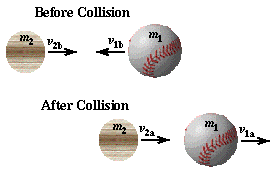Collisions and the Conservation of Momentum
By: X Bats
The impact between bat and
ball is a collision between two objects, and in its simplest analysis the
collision may be taken to occur in one-dimension. In reality most collisions
between bat and ball (especially the ones I am able to make) are glancing collisions
which require a two-dimensional analysis. It turns out, in fact, that a
glancing blow is necessary to impart spin to the ball which allows it to travel
farther.
[5] Maybe
I'll write about this more interesting, but more difficult problem later, but for
right now I'll keep things simple and look at the collision in one-dimension
only. The ball,
m1, and bat,
m2, both have initial velocities
before the collision (subscript "b"), with the ball's velocity being
negative. After the collision (subscript "a") both bat and ball have
positive velocities. The before and after velocities and the masses of bat and
ball may be related to each other through the physical relationship known as
the conservation of linear momentum. Linear momentum is the product of the mass
and velocity of an object,
p=
mv. If the
net force acting on a system of objects is zero then the total momentum of the
system is constant. While the bat and ball are in contact the player is
exerting a force on the bat; the force needed to swing the bat. So, in a
completely correct analysis, momentum is not constant because of this force
exerted by the player swinging the bat. However, the force on the bat by the
player is very much smaller than the
forces between bat and ball during
the collision, and the contact time between ball and bat is very short (less
than 1 millisecond). This allows us to ignore the force on the bat by the
player during the collision between ball and bat without significantly
affecting our results. If we ignore the force by the player on the bat, we can
express the conservation of linear momentum by setting the total momentum
before the collision equal to the total momentum after the collision.

Usually when a student encounters the
conservation of momentum in a physics course the masses of both objects are
given, along with the initial velocities before the collision. A typical
homework or quiz question would be to determine the final velocities of the two
objects after the collision. When one is searching for two unknown quantities
one must have two equations. So, we need more than just the conservation of
momentum. For our student in a physics course this second equation is usually the
conservation of energy. The conservation of energy relates the change in
kinetic energy (associated with motion), the change in potential energy
(associated with springs and position), and any work done by nonconservative
forces (like friction) which act on the system. The change in kinetic energy
includes information about the velocities of the ball and bat before and after
the collision. During the collision the ball undergoes a significant amount of
compression, and damping forces convert much of the ball's initial kinetic
energy into heat. The change in potential energy and work done by friction
describe how much of the initial energy is lost during compression of the bat
and ball. The manner in which these energies are related during the
bat-ball collision is
rather complicated. However, the effective relationship between the elastic
properties of the ball and the relative velocities of bat and ball may be
summarized in terms of the
coefficient of restitution, (e)

The coefficient of restitution of a baseball or
softball decreases with increasing incoming ball speed (
v1b). Modern baseballs are
manufactured to have a coefficient of restitution of 0.55 for a 90mph pitch
speed, while softballs are manufactured to have
e=0.44 for
pitch speeds of 60 mph. Assuming a constant pitch speed, we can combine two
equations above and do a little algebra to solve for the velocity of the
baseball after the collision:

This equation
tells us how the batted ball velocity (
v1a)depends on the
mass of the ball (
m1) and bat (
m2), the
elasticity of the ball (
e), the pitched ball speed (
v1b)
and the bat swing speed (
v2b). The properties of the ball may
be treated as constants since they don't change during a turn at bat. The
hitter has no control over the pitched ball speed, and while it may vary
considerably from pitch to pitch we'll assume that it is a constant. The only
two remaining variables which determine the final velocity of the ball are the
mass of the bat,
m2 and the initial speed of the
bat,
v2b. If we know these two parameters, we can
predict the batted ball speed. As we will see, however, the problem is
complicated somewhat by the fact that the speed with which a player can swing a
bat depends on the weight of the bat.







